NIF & PS People - 2017
October
John Heebner Elected Fellow of the Optical Society
Move Over, Einstein: Boy Genius Aims for the Stars
LLNL Scientists Featured at APS Plasma Physics Meeting
Bob Kirkwood Named APS Fellow
Physicist Bob Kirkwood has been elected a 2017 Fellow of the American Physical Society (APS) by the APS Council of Representatives. On the recommendation of the APS Division of Plasma Physics (DPP), Kirkwood was cited for “exceptional experimental work demonstrating the importance of energy transfer between laser beams in plasmas, and subsequent intellectual leadership of the effort to develop a two-color option on the National Ignition Facility laser that is important for achieving symmetric implosions.”
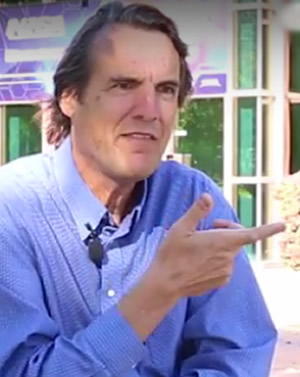 Bob Kirkwood
Bob Kirkwood Kirkwood joins LLNL Director Bill Goldstein and mechanical engineer Nathan Barton as the Laboratory’s APS Fellows for 2017. The number of APS Fellows elected each year is limited to no more than one half of one percent of the membership. It is a prestigious recognition by a scientist’s peers of outstanding contributions to physics.
Kirkwood received the 2012 John Dawson Award from the APS for “predicting and demonstrating the technique of laser scatter on self-generated plasma-optics gratings that enables generation and redirection of high-energy laser beams important for indirect drive inertial confinement fusion and high-power laser-matter interactions.” For a recent example of Kirkwood’s research on plasma optics, see “Plasma Optic Combines NIF Lasers into ‘Superbeam’”
Kirkwood received his bachelor’s and master’s degrees in electrical engineering from UCLA in 1982 and 1984 and his PhD in applied plasma physics from MIT in 1989. He worked at TRW corporation from 1984 to 1985, where he received a graduate fellowship and designed particle diagnostics for magnetic mirrors.
AT MIT, Kirkwood developed the first cyclotron absorption diagnostics for tokamaks and was awarded the APS’s Marshall N. Rosenbluth Outstanding Doctoral Thesis Award. He later worked at Caltech, developing wave-current drive, and as staff physicist at the Air Force Phillips Lab, remotely studying energetic particles on shuttle flights.
Kirkwood joined LLNL in 1994 to help initiate the NIF program. He led experiments on multi-beam interactions which led to wavelength tuning of drive symmetry on NIF and current models of multi-beam backscatter. He directed independent programs on plasma pulse compression and amplification and developed optical and x-ray diagnostics techniques for NIF.
“With so many of the scientists I most respect and admire among the ranks of APS Fellows,” Kirkwood said, “it is both gratifying and humbling to be tapped to join this group. The APS and the Division of Plasma Physics are among the most respected of the organizations that support the development of science. I have been fortunate that my collaborations with so many extremely talented scientists working in plasma physics and fusion, and the support of LLNL and DOE, have enabled accomplishments that merit this recognition from the APS.”
Kirkwood’s fellowship certificate is being presented this week at the DPP annual meeting in Milwaukee, Wisconsin.
John Heebner Elected Fellow of the Optical Society
NIF & Photon Science optics researcher John Heebner has been elected a fellow of the Optical Society of America (OSA). Heebner was cited for his “numerous innovations, achievements and technical leadership in high energy laser systems and integrated optics including nonlinear optical microresonators and ultrafast light deflectors.”
Heebner leads the Laboratory’s Ultrafast Optical and Electronics Systems Group, whose members support multiple Lab programs and are pioneering diagnostic techniques bridging the gap between ultrafast (subpicosecond) optics and high-bandwidth (more than 10 GHz) electronics.
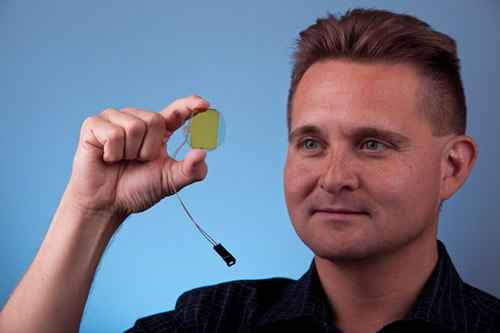
At LLNL, Heebner developed the chipscale Serrated Light Illumination for Deflection-Encoded Recording (SLIDER) deflector that set a world record for the fastest deflection of a light beam. Heebner also served as lead scientist for the front end of the NIF laser system. He later led the development of a system of 48 optically addressable, programmable spatial shapers known as LEOPARD (Laser Energy Optimization by Precision Adjustments to the Radiant Distribution) that shape the NIF laser beams to safely optimize the extraction of energy from the main amplifiers.
Most recently, he designed the architecture for the high-contrast front end of the NIF Advanced Radiographic Capability petawatt upgrade. He has been awarded four R&D 100 awards and seven patents and has authored more than 70 technical articles.
“It’s truly an honor to be elected a fellow of the Optical Society of America,” Heebner said. “It’s humbling to be included among scientists and engineers I’ve looked up to as role models. I also am lucky to have worked with amazing colleagues and am thankful that LLNL gave me the opportunities to realize accomplishments that would not have otherwise been possible.”
Founded in 1916, OSA is the leading professional association in optics and photonics, home to accomplished science, engineering, and business leaders from all over the world. Fellow membership in OSA is limited to no more than 10 percent of the membership and is reserved for members who have served with distinction in the advancement of optics and photonics.
Move Over, Einstein: Boy Genius Aims for the Stars
He’s been called the next Einstein because of his understanding of particle physics, while his perfect pitch has drawn comparisons to Mozart. He has set a goal of building his own star, which he plans to place somewhere in the Andromeda galaxy. He’s confident he can help NASA with its first manned mission to Mars.
And he’s only eight years old.
“Boy genius” Romanieo Golphin Jr. came to LLNL earlier this month to visit NIF, discuss the discovery of recent elements added to the periodic table, and learn about the use of new materials in additive manufacturing. His visit was part of a series of trips to such places as the European Organization for Nuclear Research (CERN) in Switzerland—where he was named a science ambassador—the Kennedy Space Center in Florida, the Jet Propulsion Lab in Pasadena, and Apple’s new headquarters in Cupertino, California.
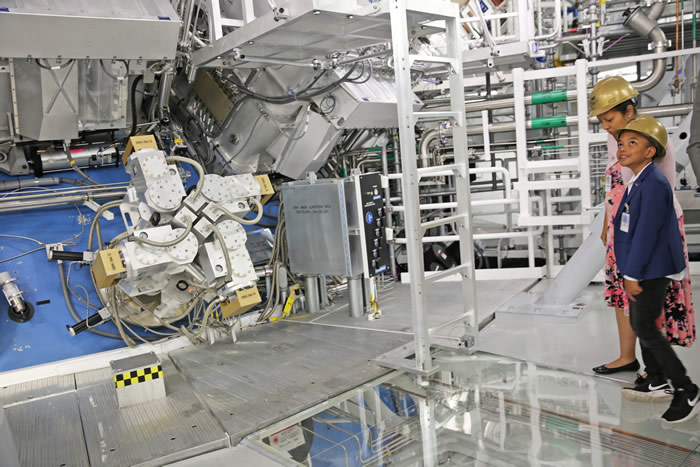 Romanieo, with his mother, Cheri Philip, spent part of his day touring NIF. Credit: Kate Hunts
Romanieo, with his mother, Cheri Philip, spent part of his day touring NIF. Credit: Kate Hunts The visits are intended to expose Romanieo to the possibilities of science and the importance of endless education. Romanieo has been invited to sit in on organic chemistry and physics courses at Morehouse College and chemistry and music classes at the University of North Carolina. He was a major part of an invited talk on early learning given by his parents at Duke University. Each time, he wowed the professors with his understanding.
Yet for all his know-how, Romanieo is very much a typical eight-year-old. He’s in constant motion—explain to him the concept behind various facets of NIF and he listens while performing the dance of the fidgety child, arms and legs constantly whirling about.
Still, he’s able to absorb all that is said to him, and he lights up when the discussion turns to plasmas. As he sits down for lunch he bemoans the presence of mushrooms in his tuna wrap and would much rather have grilled cheese, or better yet, a lollipop.
But as the process to discover new elements is discussed during the meal, he rattles off the names of various elements much as other children would discuss their Pokemon. He can recite the position each element occupies on the periodic table, whether it conducts or attracts, the number of protons in the nucleus, or any other special property. And when he walks into the Laboratory’s additive manufacturing laboratory and sees new materials neatly laid out, his parents can hardly contain him as he eagerly asks which ones he can pick up or whether he can experiment with a glovebox.
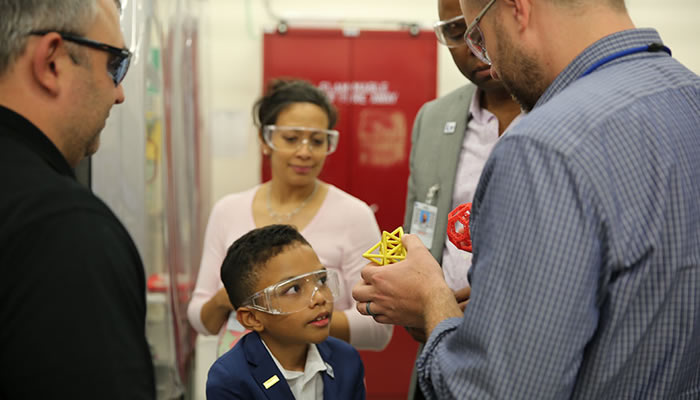 Romanieo learns about the use of new materials in additive manufacturing from Chris Spadaccini (left) and Eric Duoss as his parents look on. Credit: Kate Hunts
Romanieo learns about the use of new materials in additive manufacturing from Chris Spadaccini (left) and Eric Duoss as his parents look on. Credit: Kate Hunts Romanieo toured NIF with NIF & Photon Science Principal Associate Director Jeff Wisoff, physicist Ron Shepherd, and engineer Ibo Matthews. He met with LLNL Deputy Director Tom Gioconda and discussed elements with chemist Nancy Stoyer. His visit closed with a look at the Lab’s work in new materials. Throughout the day he was asked what he wanted to be when he grew up, which prompted him to discuss his goals of creating a star or traveling to Mars. He also wants to learn more about music and how to cook and sketch.
Romanieo knows he is different from most kids. That may explain why he constantly asks those around him about their scientific know-how—but not to show off what he knows. His playful nature often comes out in his answers; when Shepherd tells him his favorite star is Sirius, Romanieo happily puns, “Are you serious?”
Romanieo’s affinity for science began showing up at the age of two. A YouTube video, taken at the family’s Maryland home, features his father asking the boy questions about the properties of hydrogen and helium. Romanieo Jr. answers nonchalantly while spooning up his Cheerios. His parents are lifelong academics—Romanieo Sr. is an educator, scientist, artist, musician, and linguist, while his mother, Cheri Philip, is a psychologist, researcher, educator, and author.
Both have doctorates, and together they founded the Robeson Group, named after civil rights activist, actor, and athlete Paul Robeson, to devise tools and strategies to teach complex subject matter to young learners. They will put their work to the test a second time in a matter of months, when Romanieo Jr.’s brother or sister is born.
“He’s looking forward to being the big brother,” Cheri said.
These are not your textbook helicopter parents. They want to make sure they can provide an education that keeps their prodigy engaged, but at the same time they are humbled by the extent to which their hosts have gone to expose their son to possibilities. They know Romanieo is special, but don’t treat him that way. They have no preference for what he makes of his life, be it in the arts or in the sciences.
“It’s important to remember right now he is very much an eight-year-old child,” said his father. “He has to have time to play and be a kid." Usually that time is taken up with Legos, the boy’s personal favorite. Romanieo Sr. described them as his son’s weakness, or “kryptonite,” and was quick to implore his hosts not to feature them as part of their presentations as others have in the past.
“If that happens, he’s gone,” he said. “You can’t tear him away.”
LLNL Scientists Featured at APS Plasma Physics Meeting
LLNL scientists had prominent roles at the American Physical Society Division of Plasma Physics meeting in Milwaukee, Wisconsin, on Oct. 23-27.
They included the winner of the James Clerk Maxwell Prize for Plasma Physics; a co-recipient of the John Dawson Award for Excellence in Plasma Physics; the winner of the Katherine E. Weimer Award for Women in Plasma Physics; and presenters of one tutorial lecture and ten invited talks.
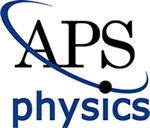
- Dmitri Ryutov won the James Clerk Maxwell Prize for Plasma Physics for contributions to the theoretical plasma physics of low- and high-density plasmas, open and closed magnetic configurations, and laboratory and astrophysical systems.
- Andrew Mackinnon was co-recipient of the John Dawson Award for Excellence in Plasma Physics along with Chikang Li, Fredrick Séguin, and Richard Petrasso from MIT, Marco Borghesi from The Queen’s University, Belfast, and Oswald Willi from Heinrich Heine University, Düsseldorf, for pioneering use of proton radiography to reveal new aspects of flow, instabilities, and fields in high-energy-density plasmas.
- Félicie Albert won the Katherine E. Weimer Award for Women in Plasma Physics for pioneering development and characterization of x-ray sources from laser-wakefield accelerators and Compton scattering gamma-ray sources for applications in high energy density science and nuclear resonance fluorescence.
- Brian Spears gave a one-hour tutorial lecture on “Contemporary Machine Learning: Techniques for Practitioners in the Physical Sciences,” while Debbie Callahan, Andrea Kritcher, Suzanne Ali, Andrew MacPhee, Steve MacLaren, Mark May, Bob Kirkwood, Dan Casey, Louisa Pickworth, and Hans Rinderknecht presented invited talks.
Science Reporters Visit NIF
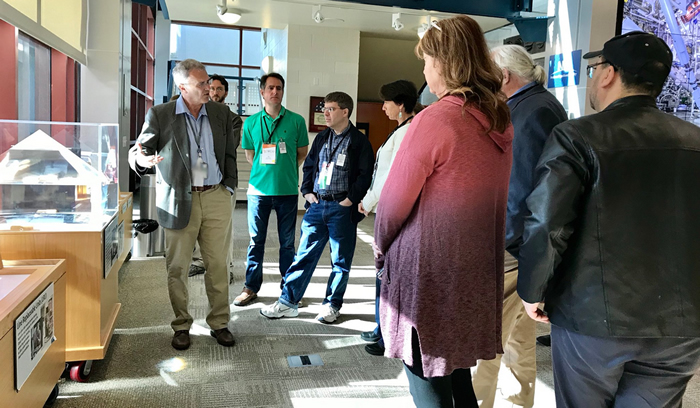 NIF & Photon Science Principal Associate Director Jeff Wisoff briefs a group of science reporters who toured NIF on Oct. 30. They were among more than 1,300 registered attendees from more than 70 countries who attended the World Conference of Science Journalists in San Francisco from Oct. 26 to 30.
NIF & Photon Science Principal Associate Director Jeff Wisoff briefs a group of science reporters who toured NIF on Oct. 30. They were among more than 1,300 registered attendees from more than 70 countries who attended the World Conference of Science Journalists in San Francisco from Oct. 26 to 30. 



